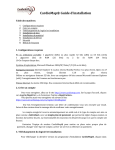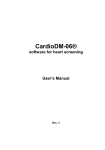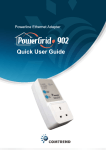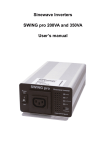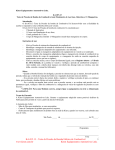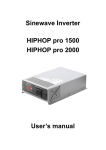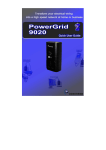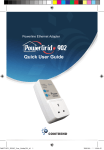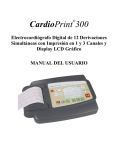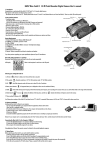Download HeartVUE system
Transcript
HeartVUE system for non-invasive screening of heart User’s Guide Read Me First Rev. 1 Pag HeartVUE system. User’s Guide Warnings 2 • Use IEC60601-1-1 standard to combine the HeartVUE system with other devices (computers and peripherals), see chapters 6.1 and 6.2. • Do not operate HeartVUE system within 3 meters of an operating cellular phone, similar radio transmitting device, other powerful radio interference producing sources such as arc welders, radio thermal treatment equipment, x-ray machines, or any other equipment that produces electrical sparks (see chapter 8.3). • Reusable electrodes present a potential risk of cross-infection especially when are used on abraded skin, unless they are restricted to a single patient or sterilized between patients. The sterilization recommendations from electrode producer should be used. • Explosion Hazard. Do not use the HeartVUE system in the presence of a flammable anesthetic mixture with air, or with oxygen or nitrous oxide. • Do not immerse the any parts of HeartVUE system in water. • Take care of the system’s components. Evoid the cables’ breaks, kinks, tension and other mechanical efforts. • Take care of arranging Patient and USB cables/wires to avoid the risk of patient entanglement or strangulation. • The operator is responsible to ensure the safety of any devices controlled or triggered by any software or hardware receiving data from the HeartVUE system. And this system must not be configured or connected in such a way that failure in its data acquisition, processing or control functions can trigger patient feedback stimulus that poses an unacceptable level of risk. • Use the special ECG electroconductive gel/paste for the ECG acquisition. • Do not spread the electroconductive gel/paste on wounded or scarred skin. • The HeartVUE system is intended for screening analysis of the ECG signals only for adults. It is not suitable for children up to the age of 12 years old. The system can be used for children and teenagers up to age 12-18 years old only for monitoring the tendencies in dispersive parameter changes. For children and teenagers the use of the system is determined by the doctor in each specific case. HeartVUE system. User’s Guide • The HeartVUE system does not diagnose! The system functions to define earlier dispersive deviations in the heart boundary states and inform about the presence of the pathology. The HeartVUE system is not a substitute the other clinical methods of heart diagnostics; it gives the additional information about the microchanges in the myocardium state. • The drug taking can influence on the accuracy of the heart portraits’ visualization and forming the conclusion and comments. If the system is used during the drug treatment it is necessary to compare the current data with the data collected before the drug taking. 3 HeartVUE system. User’s Guide Manufacturer and representatives The Manufacturer is Medical Computer Systems Ltd. ADDRESS: PHONE: FAX: E-MAIL: INTERNET: Passage 4922, 4-2, Zelenograd, Moscow, 124460, Russia +7 495 913 31 94 +7 495 913 31 95 [email protected] www.mks.ru The European Representative is HeartView – Europe ADDRESS: PHONE: FAX: E-MAIL: Talstrasse 20, CH-8001, Zurich, Switzerland +41 1 212 60 06 +41 1 212 60 07 [email protected] The World Representative is Heart View LLC ADDRESS: PHONE: FAX: E-MAIL: 6805 Mayfield Rd., Ste. 1203 Cleveland, OH 44124, USA +1 440 829 55 90 +1 440 442 56 29 [email protected] Document number: 3180. The manufacturer has the right to alter this document according to the changes made by manufacturer for improving the system. Print errors which may be presented in this guide will be corrected in future editions. 4 HeartVUE system. User’s Guide Contents Warnings ........................................................................2 Manufacturer and representatives..................................4 Contents..........................................................................5 1. Abbreviations..............................................................6 2. Symbols on labels........................................................7 3. Main features...............................................................8 4. General information..................................................10 5. Installation..................................................................12 6. External components.................................................19 7. Malfunctions and their correction...............................21 8. Specifications.............................................................23 5 HeartVUE system. User’s Guide 1. Abbreviations Term CPU Central processing unit DC Direct current ECG Electrocardiogramm EMC Electromagnetic compatibility LED Light emitting diode MCS Medical Computer Systems, Ltd OS Operational system PC Personal computer RF Radio frequency USB 6 Meaning Universal serial bus HeartVUE system. User’s Guide 2. Symbols on labels Symbol Meaning Electrical medical device, CLASS II EQUIPMENT. Electrical medical device, TYPE CF with defibrillator protection. Attention. Carefully read specification or instruction for use. This device conforms to Directive 93/42/EEC. USB connector. Serial number. Date of manufacturing. Separate collection with electrical and electronic equipments for recycling. 7 HeartVUE system. User’s Guide 3. Main features 3.1 Intended use The HeartVUE is a computer system for easy and efficient non-invasive screening of heart which provides a rapid 3-D colored image of heart by using 6 standard ECG leads (4 wires only from the patient's wrists and ankles). This system contains the PC-ECG module KARDi2/4 and the CardioDM06® software that converts the electric conductivity of the cardiac tissue into a 3dimensional, color-coded image which is simple for physicians to interpret. The basic operating principals of the CardioDM-06® software are described in the “CardioDM-06® software for heart screening. User’s Manual”. The HeartVUE system will prove to be an invaluable screening tool for cardiologists, general practitioners, clinics, hospitals, the fitness industry, sports teams and emergency medical facilities. 3.2 Basic Functionality The basic features of the HeartVUE system are: 1. the 30 or 60 second ECG acquisition of the 6 standard leads (I, II, III, aVR, aVL, aVF) by KARDi2/4, analyzing and visualization; 2. analyzing and creating the 3D colored image of heart (later the heart portrait) where a state of the heart zones is displayed by colors; 3. analyzing and showing the “Myocardium”, “Rhythm”, “Pulse” and “Detailing” indices; 4. the conclusion and comments creating. Pic.1 The basic features’ diagram of the HeartVUE system. 8 HeartVUE system. User’s Guide 3.3 Classification The HeartVUE system is а Class IIa device according to Council Directive 93/42/EEC for medical devices. The system is classified for CLASS II TYPE CF EQUIPMENT according to IEC 60601-1 (protection against electric shock). The system classified by CISPR 11 standard as a Group 1, Class B equipment according to IEC 60601-1-2 (electromagnetic compatibility). For more information about EMC see chapter 8.3. 9 HeartVUE system. User’s Guide 4. General information 4.1 Packaging The following items form the whole package: 1. PC-ECG module KARDi2/4 with fixed USB cable. 2. Clamp ECG electrodes (see chapter 6.3). 3. The CD disk with driver and CardioDM-06® software. 4. HeartVUE system. User’s Guide (this document). 5. CardioDM-06® software for heart screening. User’s manual. 6. Special fastener for the system fixation (see chapter 5.3). 7. USB key for the software protection. 8. Optional PC and/or printer. 9. Case for all aforementioned items. 4.2 Warranty, service life and utilization The system and all equipment according to the chapter 4.1, excluding the ECG electrodes, special fastener and case, are guaranteed to be free from defects in material and workmanship for 24 months from the date of purchase. In the unlikely events that repair is necessary, call the manufacturer representative to receive a Return Authorization. Then send the unit back by a traceable method – the manufacturer representative is not responsible for not received items. We will repair or replace your unit(s) free of charge. This warranty does not apply to damage incurred through accident, alteration or abuse. The HeartVUE systems’ average service life is not less than 5 years if the mean time of system’s operating does not exceed 80 hours per month. Utilize the system according to your regional laws. In the European Union use the requirements of the Directive 2002/96/EEC for the system utilization. 10 HeartVUE system. User’s Guide 4.3 Maintenance Regularly use surface disinfectants, but not less than one time in the month. For material compatibility use the disinfectants based on the alcohol. Factory testing and calibration ensure equipment accuracy and frequency response during the whole system’s life cycle. If necessary, contact the manufacturer representative for factory re-calibration. 11 HeartVUE system. User’s Guide 5. Installation 5.1 Hardware installation Pic.2 The KARDi2/4 PC-ECG module: left picture – the front side, right picture – the back side. 1. Unpack the package and check that all parts of the system according to the chapter 4.1 have been received and are undamaged. The face of PC-ECG KARDi2/4 module is showed on the left picture, the back side is showed on the right one. 2. Fixate the KARDi2/4 PC-ECG module on the surface using the special fastener (see chapter 5.3). 3. Turn on the PC and wait till the Windows OS will be loaded. Make sure that the PC meets the requirements of the chapters 6.1 and 6.2. 4. Insert the CD disk with driver and CardioDM-06® software in the CD-ROM. 5. Plug the USB cable of the KARDi2/4 PC-ECG module, which has the USB cable label, into the free USB port of the PC or of the USB hub with the external power source. If it is for the first time, the driver installation procedure will run automatically (refer to chapter 5.1.1). 12 HeartVUE system. User’s Guide 6. Install the CardioDM-06® application software (see chapter 5.2). 7. Plug the USB protection key, which has the HeartVUE-K label, into another free USB socket of the PC. The key should be plugged in the computer’s free USB socket ONLY if the installation of the CardioDM-06® software is finished (also see chapter 3.3 of the CardioDM-06® software for heart screening. User’s Manual). 8. Connect ECG electrodes to the ECG connectors (see chapter 6.3). 9. Read the “CardioDM-06® software for heart screening. User’s Manual” document and use the CardioDM-06® software to operate with KARDi2/4. 10.Place the ECG electrodes to the patients’ wrists and ankles and start a new examination. 5.1.1 Driver first time installation After first connection KARDi2/4 to PC (see chapters 6.1 and 6.2.) by USB cable, Windows will show the message Found new hardware and start the wizard dialog Found New Hardware Wizard for new device installation. The dialog windows for Windows XP OS are shown below. For other version of Windows OS the dialog may be different. 1. When Windows asks to connect to Windows Update, select No, not this time and the press Next button. 13 HeartVUE system. User’s Guide 2. Windows will ask to install software automatically or from specific location. Select Install from a specific location and press Next. 3. Select Search for the best driver in these locations and check Include this location in the search. Use Browse button to select directory where the driver’s files are located (for example – D:\Driver) and press Next. 14 HeartVUE system. User’s Guide 4. Windows will show the installation progress for driver’s files within few seconds. At the end of installation press Finish button. 5. To check that the driver installation was successful verify that in the Device Manager the KARDiDSP appears under the MCS USB Medical Devices. 15 HeartVUE system. User’s Guide 5.1.2 Driver update For updating the driver double-click on the KARDiDSP device in the Device Manager. From the dialog select Driver property page and press the Update Driver… button. 1. Alternatively, right-click on the KARDiDSP in the Device Manager and then select Update Driver from the context menu. 2. Then follow the Hardware Update Wizard and perform the same steps as during the first time installation. After getting to the following dialog select Don’t search. I will choose the driver to install. Press Next button. 16 HeartVUE system. User’s Guide 3. Press the Have Disk…button. 4. Then select location of the driver’s files and press OK. 5. Then press Next button to start the installation process and wait till the finish dialog will appear. 17 HeartVUE system. User’s Guide 5.2 Software installation and operation The installation description of the CardioDM-06® software for heart screening you can find in the applicable document “CardioDM-06® software for heart screening. User’s Manual”. This document includes the operation documentation too. 5.3 The PC-ECG module fixation For fixating the KARDi2/4 PC-ECG module on the surface use the special fastener which consists of continuous strips of plastic backing, with plastic mushroom shaped stems protruding up from the backing strip. The first part of the fastener you can find on the back side of the KARDi2/4. The second part of the fastener is a substrate which can be found in the package. The substrate has a protective liner. Remove the protective liner and press firmly onto the substrate for full surface contact. All surfaces must be clean, dry, and free of oil, grease, dust etc. The special fastener is disposable and permanent. Be attentive at a choice of an attachment place of the fastener! When two pieces of the fastener are pressed together, the mushroom heads interlock with one another with an audible snap. To open, simply pull apart. 18 HeartVUE system. User’s Guide 6. External components 6.1 Safety with system For connecting the HeartVUE system with other devices (computers and peripherals – printers, scanner etc) use the IEC60601-1-1 standard about safety requirements of medical electrical systems. The system is typically used inside the PATIENT ENVIRONMENT (area near 1.5 meters around the patient, see pic.3), that is why all the other devices used with the system should be medical and meet the requirements of the IEC60601-1 standard (for example, PC Advantech POC-174). Pic 3 Example of the PATIENT ENVIRONMENT If non-medical devices are connected to the system via USB and if it is inside the PATIENT ENVIRONMENT then: 1. all devices have to be connected to the medical (IEC60601-1) isolation transformer (transformers) with sufficient power supply (for example, AEL Group MIT Medical Isolation Transformers) or 2. all devices should be powered from internal energy sources. However, the PC-ECG module has minimum 3 meters cable to PC with USB connector fixation and touch protection construction. The isolation transformer may not be used if the guaranteed minimal distance to any non-medical device, which meet the requirements of the IEC60601-1-1 standards, will be more than 1.5 meters (outside PATIENT ENVIRONMENT). 19 HeartVUE system. User’s Guide 6.2 Computer and peripheral devices Connected computer, as well as others peripheral devices, like printers, must have mark and comply with the safety standard for office machines (DIN VDE 0805 or EN60950 or IEC950 or any). Computer must conform to minimal requirements: • CPU with equivalent performance not less than Intel Celeron1000MHz. • Run under Microsoft Windows XP OS. • Has two free USB1.1 or compatible port. The CardioDM-06® software uses the graphic standard DirectX for the heart portraits’ visualization. Make sure that all the latest updates for the Windows OS or its applications, and that the latest USB patches or drivers made by the PC’s or system board’s developers, are installed on the PC. 6.3 ECG electrodes and electroconductive gels/pastes For ECG acquisition the ECG electrodes must have the mark and the maximum polarization voltage less 300 mV should be used. These electrodes (or wire to electrode) must have the 4 mm socket for connection. For example, the FIAB F9024 (nickel-silver) or F9024SSC (nickel-silver chloride) clamp electrodes may be used. Other types of electrode connectors can be used by adapter (3 mm socket, snap type, etc). For example, the FIAB PG922/4T snap adapter may be used for disposable electrode connection. The electroconductive gel/paste used for the ECG acquisition must have the mark. For example, NUPREP EEG & ECG Skin Prepping Gel. 20 HeartVUE system. User’s Guide 7. Malfunctions and their correction The possible malfunctions and actions for their correcting are in the following table. Malfunction Probable reason The CD disk cannot be read The CD disk became dusty. by the CD-ROM. Corrective actions Extract the CD disk from the CDROM and carefully clean the dick with the cleaning based on the alcohol. If the malfunction is not corrected contact the manufacturer representative. The New examination button is not active. The PC-ECG module is not plugged to the PC. The driver is not installed. Check the USB cable connection. Make sure that the PC-ECG module KARDi2/4 is plugged into the USB hub with the external source of power. Install the driver (see chapter 5.1.1). If the driver is installed update it (see chapter 5.1.2). Restart the program. The indicator “Mode” is red. The error occurred. Replug the PC-ECG module. Reinstall the system driver. If the malfunction is not corrected contact the manufacturer representative. The MCS USB Medical Devices is not appeared in the Computer management. The KARDiDSP is not displayed in the Device Manager under the MCS USB Medical Devices. The connection between PC Check the connection between PC and PC-ECG module and PC-ECG module, or failure. replug the PC-ECG module. The system driver is not installed. Install the system driver. The heart portraits have a black line. The fonts or buttons of the CardioDM-06® software’s interface are changed. The video drivers are not updated. Update the video drivers. If the malfunction is not corrected contact the manufacturer representative. 21 HeartVUE system. User’s Guide Malfunction The screening analysis takes more time than 1 minute. Probable reason The CardioDM-06® software has been run with the concurrently running programs (especially with the antivirus monitors). Corrective actions Close the other running programs, especially the antivirus monitors. All (or one) of the ECG The electrodes (or the Check the electrode cable’s signals are not displayed on electrode of this lead) are connection. Check the electrode the screen. not connected to the patient. cable’s fixation in the electrode. PC-ECG module failure. Check the connection between the electrode and the patient. If the malfunction is not corrected contact the manufacturer representative. All (or one) of the ECG signals are very noisy. The electrodes (or one electrode) are not greased with the electroconductive paste/gel. Grease the electrodes (or one needed electrode) with the electroconductive paste/gel. Operate the system in the prescribed conditions. Read the Warning about conditions of system’s operating. 22 HeartVUE system. User’s Guide 8. Specifications 8.1 Main functions Function Value ECG acquisition The ECG acquisition of the 6 standard leads (I, II, III, aVR,aVL, aVF) by KARDi2/4 PC-ECG module. Heart portrait The heart portrait is “a snap shot” on display as a result of calculating mean dispersion characteristics of low-amplitude fluctuations during ECG input. “Myocardium” indicator The “Myocardium” indicator is relative characteristics, which describe the total value of dispersion deviations and range from 0% to 100%. “Rhythm” indicator The “Rhythm” describes the changes in the R–R intervals variability characteristics in range from 0% to 100%. “Pulse” indicator The “Pulse” shows the quantity of the heartbeats in a minute defining bradycardia, tachycardia or normal condition. “Detailing” indicator The “Detailing” describes the heart condition using the analysis of the described above indices. 8.2 KARDi2/4 PC-ECG module Parameter Value Number of channels The HeartVUE system has 3 monopolar channels. The ECG leads are calculated on the PC by CardioDM06® software Analog front end DC amplifiers Input range (effective resolution for 500Hz output data rate) ±410 mV (2 uV) Defibrillator protection on base semi-conductors elements Input DC impedance greater 70 MOhm according to N electrode Check electrode connection Checking connection during registration by measure of DC offset Analog-to-digital conversion Sigma-delta modulation with frequency 2048kHz simultaneously on all channels, a digital filtration and 23 HeartVUE system. User’s Guide Parameter Value decimation up to frequency 16kHz Digital signal processing Filtration and decimation up to 500 Hz output data rate (20-bit resolution). Internal low pass filters has the -3 dB level on 150 Hz and 5% level on 100 Hz accordingly Connectors type for electrode 4 mm banana jacks Galvanic isolation Reinforced according to IEC60601-1 from PC side Power line USB Voltage +5 V ± 10% Maximal current in active mode less 280 mA Computer Interface USB1.1, full speed mode, plug-and-play support Status indicators and modes Bi-color LEDs indication: • green – no error, active mode. The indicator is burning green during the new examination’s making • red – error occurred USB cable Min length 3 m, fixed to module Electrode cable’s length not less than 140 cm Dimensions of enclosure 100x65x28 mm Weight with cables less 350 gram Working temperature +10ºC…+35ºC Storage temperature +5ºC...+40ºC Transportation temperature -30ºC...+50ºC Humidity up to 97% without condensation Mechanical resistance According to IEC 60601-1 24 HeartVUE system. User’s Guide 8.3 Electromagnetic compatibility Guidance and manufacturer’s declaration – electromagnetic emissions The HeartVUE system is intended for use in the electromagnetic environment specified below. The customer or user of the system should assure that it is used in such an environment. Emission test Compliance Electromagnetic environment – guidance RF emissions Group 1 The system uses RF energy only for its internal function. Therefore, its RF emissions are very low and are not likely to cause any interference in nearby electronic equipment. Class B The system is suitable for use in all establishments other than domestic and those directly connected to the public low-voltage power supply network that supplies buildings used for domestic purposes. CISPR 11 RF emissions CISPR 11 Harmonic emissions Not applicable IEC 61000-3-2 Voltage fluctuations/ flicker emissions Not applicable IEC 61000-3-3 Electrostatic discharge (ESD) ±6 kV contact ±6 kV contact IEC 61000-4-2 ±8 kV air ±8 kV air Electrical fast transient/burst ±2 kV for power supply lines Not applicable ±1 kV for input/output lines ±1 kV for input/output lines Floors should be wood, concrete or ceramic tile. If floors are covered with synthetic material, the relative humidity should be at least 30 %. IEC 61000-4-4 25 HeartVUE system. User’s Guide Guidance and manufacturer’s declaration – electromagnetic emissions Emission test Compliance Electromagnetic environment – guidance Surge ±1 kV differential mode Not applicable ±2 kV common mode Not applicable Interruptions and voltage variations on power supply input lines <5% UT (>95% dip in UT) for 0,5 cycle Not applicable IEC 61000-4-11 40% UT (60% dip in UT) for 5 cycles Not applicable 70% UT (30% dip in UT) for 25 cycles Not applicable <5% UT (>95% dip in UT) for 5 sec Not applicable 3 A/m 3 A/m IEC 61000-4-5 Power frequency (50/60 Hz) magnetic field IEC 61000-4-8 26 Power frequency magnetic fields should be at levels characteristic of a typical location in a typical commercial or hospital environment. HeartVUE system. User’s Guide Immunity test IEC 60601 test level Compliance level Recommended separation distance Portable and mobile RF communications equipment should be used no closer to any part of the system, including cables, than the recommended separation distance calculated from the equation applicable to the frequency of the transmitter. Conducted RF IEC 61000-4-6 3 Vrms 150kHz to 80MHz Radiated RF IEC 61000-4-3 3 V/m 80MHz to 2,5GHz 3 Vrms 3 V/m d = 1.17 P d = 1.17 P 80 MHz to 800 MHz d = 2.33 P 800 MHz to 2,5 GHz Where P is the maximum output power rating of the transmitter in watts (W) according to the transmitter manufacturer and d is the recommended separation distance in meters (m). Field strengths from fixed RF transmitters, as determined by an electromagnetic site survey,a should be less than the compliance level in each frequency range.b Interference may occur in the vicinity of equipment marked with the following symbol: NOTE 1 At 80 MHz and 800 MHz, the higher frequency range applies. NOTE 2 These guidelines may not apply in all situations. Electromagnetic propagation is affected by absorption and reflection from structures, objects and people. a Field strengths from fixed transmitters, such as base stations for radio (cellular/cordless) telephones and land mobile radios, amateur radio, AM and FM radio broadcast and TV broadcast cannot be predicted theoretically with accuracy. To assess the electromagnetic environment due to fixed RF transmitters, an electromagnetic site survey should be considered. If the measured field strength in the location in which the system is used exceeds the applicable RF compliance level above, the system should be observed to verify normal operation. If abnormal performance is observed, additional measures may be necessary, such as reorienting or relocating the system. b Over the frequency range 150 kHz to 80 MHz, field strengths should be less than 3 V/m. 27





























